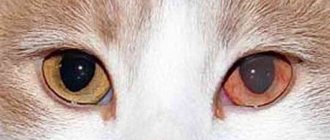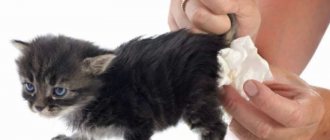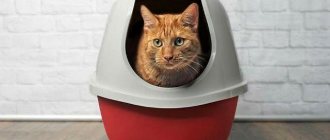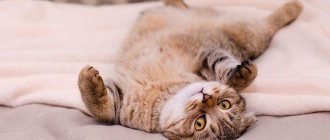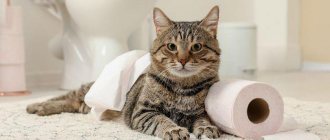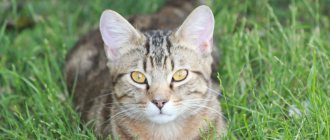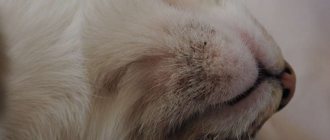Should cat owners be concerned if they find blood or mucus in their cat's stool? In this article, we describe in sufficient detail the probable causes of these phenomena and answer the main question: “is it dangerous?”
We all do it. We do this every time we change the tray or hear claws scraping the litter. I'm talking about examining our cat's poop. We humans have an inexplicable interest in monitoring the waste products of our companion. And this is good. Identifying a litter box problem early can prevent more serious complications and restore the health of a sick kitten. According to statistics, intestinal upset/diarrhea is the sixth most common disease in cats. One of the most common intestinal problems reported by cat owners is blood or mucus in the stool. Should you be concerned if you notice drops of blood or clots of mucus in your cat's litter box? Let's find out.
What does normal cat stool look like?
Typical cat poop is about 5-6 cm long, 1 cm in diameter, well formed and predominantly brown in color. If your cat has abnormal bowel movements, you can give your assessment of the feces. Assessing the quality of feces and estimating the quantity can help your veterinarian diagnose your cat's condition more quickly and correctly.
Most cats defecate once a day. The smell should not be too strong. When changing the tray, you may notice that normally the stool should not be liquid.
Treatment of the disease
There can be no self-medication when such symptoms are detected. After testing, medications and preventive measures are prescribed to cure the disease. On the first day, it is recommended to unload the body from food; only water is allowed. Further, the following drugs are used for each ailment separately:
- Viral infections. Treat with subcutaneous injection of antiviral serum.
- Bacterial diseases. Only antibiotic therapy will help.
- Poisoning and intoxication. The medication "Atoxil" is prescribed.
- Worms. Antihelminthic drugs solve this problem.
- Intestinal microflora disorders. Probiotics are needed for a course of at least 10 days.
- Spasms. Antispasmodic drugs are prescribed, especially for acute pain.
After treatment, cats easily return to normal, and the functioning of the intestines and esophagus improves. The animal goes to the toilet painlessly, for the most part, it does not secrete white mucus and there is no transparent ichor in the impurities. To summarize, we can say that blood and mucus in a cat’s stool are considered pathological secretions and signal the development of the disease. This cannot be left to chance; you must consult a specialist if additional symptoms appear.
What does blood look like in my cat's stool?
Blood in a cat's stool can be difficult to detect. For starters, cat litter can sometimes change color and hide or create changes in the appearance of the stool. If the blood originates in the lower intestine, especially the distal colon or rectal area, it will most likely appear as blood. Red or pink drops or smears are often found on the sides of the cat's litter box and on the top of the stool or litter.
Blood from the upper intestinal tract, especially the small intestine, will be black or brown. This color change is due to partial digestion by enzymes secreted in the small intestine. This blood often appears as dark spots, streaks, or looks like coffee grounds.
It's important to note that both constipation and diarrhea can cause blood in a cat's stool. Bright red blood without diarrhea or hard, dry stool usually indicates the problem is closer to the rectum and anus.
Predisposing factors
The causes of diarrhea are very diverse, some of them pose a serious danger to the life and health of your pet. Animals adopted from cat shelters are at particular risk: they often suffer from feline panleukopenia, giardiasis and coccidiosis. Viral infections are very dangerous, as they greatly weaken the already not very “powerful” body of children.
However, much more often, much more “harmless” factors lead to the appearance of diarrhea, including nutritional characteristics.
Therefore, we will look at the effect of diet:
- So, a very common cause of diarrhea in kittens is sudden “perturbations” in their diet. Remember that young animals are very sensitive to dietary changes! Therefore, when taking a kitten from a shelter or from another breeder, be sure to ask how and what it ate. You should gradually accustom your pet to new food by adding new food to its old diet. There is no need to rush, as otherwise your pet will be guaranteed diarrhea.
- Overfeeding. Kittens need to be fed often, but in small portions. Their intestines are simply unable to digest large quantities of food.
- Intolerance to certain foods. If you notice that after some food your cat immediately begins to diarrhea, do not use it in the future.
- Kitten eating spoiled food. Often it is not the owners’ direct fault: if a pet gets into the trash can, it will almost inevitably eat “something wrong.” The natural result of this will be diarrhea.
- Cow's milk. Many breeders firmly believe that cats cannot live without it. This is a dangerous misconception. Cow's milk contains a lot of lactose, and most kittens' bodies cannot digest it. Their endocrine glands do not produce the required amount of this enzyme. Because of this, milk that enters the kitten’s digestive tract is not digested, but curdles. A lot of casein clots are formed, richly saturated with microflora. And all this “wealth” begins to rot right in the kitten’s intestines. It is not surprising that he quickly develops thin, mucous diarrhea.
Poisoning
Note that diarrhea is a common consequence of poisoning with organic and inorganic poisons. They should be suspected first of all when the kitten has not only diarrhea, but also vomiting. The effect of toxins on the digestive tract of kittens often leads to the destruction of its epithelial layer. Mucous inclusions in fecal matter are accumulations of exfoliated and destroyed epithelial cells. In veterinary practice, cases of poisoning with various types of household chemicals are very common. It should be kept out of the reach of pets and small children! Poisoning is also common in kittens that have free access to the outdoors.
During a walk, kids can eat anything, and it’s good when all they end up with is diarrhea. Salts of heavy metals can generally lead to the rapid and sudden death of your pet! In addition, yellow mucous diarrhea in case of poisoning indicates liver damage.
What about mucus in the stool?
Slippery. Slimy. Nasty. These are all words veterinarians hear from cat owners describing excessive mucus in their cats' stool. Mucus is a normal secretion of the intestinal tract to help lubricate and moisten the intestines and facilitate fecal passage. It is not uncommon to observe some greasy or slippery coatings on your cat's feces. It is abnormal to see a lot of mucous, often clear to pale yellow-green fluid, accompanying your cat's bowel movements. Fecal mucus is an example of “the more the merrier.”
Diarrhea of infectious etiology
Bacterial infections pose a great danger to the health and life of every kitten:
- Campylobacteriosis. This is a zoonotic bacterial pathology that often affects kittens less than six months old. The infection is transmitted through direct contact with sick animals, as well as through consumption of food and water contaminated with the pathogen.
- Pathogenic strains of E. Coli, that is, common Escherichia coli. The general name of such pathologies is escherichiosis. They are extremely dangerous, since some strains have a hemolytic effect, causing not only diarrhea, but also multiple intestinal bleeding.
In addition, gray mucous diarrhea is a fairly characteristic sign of salmonellosis. Like campylobacteriosis, the infection is transmitted by eating poor quality food. It is severe and the likelihood of death is very high. In addition to bacterial infections, various viral infections often lead to the development of diarrhea. Diarrhea is most typical for rotavirus, as well as infectious enterocolitis.
What causes blood or mucus in my cat's stool?
There can be many reasons for blood or mucus in your cat's stool. Some common reasons include:
- Dietary changes and food intolerances;
- Inflammatory bowel diseases (IBD);
- Intestinal parasites such as Giardia;
- Infections;
- Trauma or abscess;
- Rectal polyps or tumors;
- anal gland abscess or infection;
- Constipation or idiopathic feline megacolon;
- Poisons or toxins;
- Cancer.
Why does my kitten have loose stools?
As we suspected, kittens can develop loose stools for many reasons, so it is important to understand them before any treatment. While you are waiting or making an appointment with your veterinarian, we recommend that you change your cat's diet.
Even if we still don't know why a kitten has diarrhea, we can change his diet to try to ease his discomfort if the diarrhea continues.
However, in these cases, the first thing we advise you to do is to withhold food for 12 hours and give small amounts of water frequently if persistent diarrhea occurs. Alternatively, a diet based on boiled chicken, without skin and fat, and rice can be arranged to be administered to the cat in small quantities over a period of several days.
© shutterstock
What will the veterinarian do to determine the cause?
Most of these problems can be diagnosed based on the animal's medical history, physical examination, and microscopic examination of the animal's stool. Your veterinarian will look for blood, parasites, bacteria, and other possible causes of blood and/or mucus. In more serious cases, X-rays, ultrasound, blood and urine tests will be performed. Treatment will be based on an accurate diagnosis.
If you notice anything strange in your cat's feces, don't hesitate; Contact us for veterinary help. We've seen too many cats for whom it was too late to get help, simply because their owners hoped to solve the poop problem on their own. And our best advice is to continue to monitor your cat litter carefully.
If you are unsure, consult with our veterinarian—they will be your best resource in determining which toys and objects are safe for your cat, and can also give you tips on how to prevent your cat from eating strange objects.
When should you see a doctor?
If an animal with such a symptom begins to look sick, then it needs a visit to the doctor.
Important symptoms are also vomiting, blood streaks in the stool, frequent diarrhea, frequent urination, increased thirst, increased body temperature, unhealthy appearance, complete or partial refusal to eat. It is recommended to monitor the cat's condition for the first few days. If the situation does not change and all the symptoms persist or develop with renewed vigor, then you must definitely contact your attending veterinarian in order to get tested and prescribe the appropriate treatment for your furry pet.
Disease prevention
The owner must do everything that depends on him so that diarrhea bypasses the pet:
- When feeding your animal with ready-made kitten food, it is better to give preference to dry food, as it does not spoil.
- Keep the bowl and drinking bowl clean, wash them regularly and scald them with boiling water.
- Timely vaccination against infectious diseases.
- Give anthelmintics to prevent helminthiasis.
- Do not leave small objects on the floor or table that the kitten could swallow.
- Introduce new foods gradually.
- Feed the kitten in moderation, making sure that it does not overeat.
- Limit your pet's contact with street animals that can be carriers of dangerous infections.
Diarrhea is a rather dangerous phenomenon when it comes to a small kitten. At the first symptoms, it is better to immediately show your pet to a doctor. You can’t hesitate - your pet can die in a matter of days from dehydration and intoxication.


